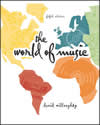|
 |  The World of Music, 5/e David Willoughby
Vocabulary for Listening and Understanding: The Elements of Music
Chapter 3:
| Melody | A succession of musical tones usually of varying pitch and rhythm that has identifiable shape and meaning. A melody may be characterized by its smooth, conjunct shape that moves mostly stepwise or its disjunct, angular shape resulting from frequent use of wide intervals (skips). It may be comprised of a wide or a narrow range of pitches.
|  |  |  | | Harmony | Pitches heard simultaneously in ways that produce chords and chord progressions.
|  |  |  | | Loudness | The degree of intensity or energy producing a sound. The loudness or softness of a tone.
|  |  |  | | Rhythm | The organization of time in music, creating patterns of long and short durations of pitches to achieve desired degrees of rhythmic energy-the rhythmic impulse.
|  |  |  | | Tone quality | All sound-producing devices possess their own distinctive tone qualities, or timbres. Instruments are generally classified according to the way their tones are produced according to their characteristic timbre. There are brass instruments, string instruments, woodwinds, and percussion.
|  |  |  | | Interaction of the elements | The elements of music are pitch, duration, loudness, and timbre. They always work together in a piece of music.
|  |  |  | | Style | Most, but not all, Western music incorporates some aspects of variety (departure) and unity (return). A departure suggests a musical idea (theme) that is different from what has already been presented; this is a point of contrast. A return is either an exact or a modified repetition of the original theme. It can be rhythmic, melodic, harmonic, or any combination of the three.
|  |  |  | | Texture | The density of sound. The number of simultaneously sounding lines. Music can have a full, thick text or a thin, transparent texture. Also, the manner in which the horizontal pitch sequences are organized determines musical texture. A single line melody with no accompaniment or other horizontal or vertical sounds has a monophonic texture; two or more independent, simultaneously sounding melodies having equal emphasis have a polyphonic texture; and a melody that is dominant with other lines supporting the main melody has a homophonic texture.
|  |  |  | | Form | The shape or structure of a piece of music. Form is determined primarily by patterns of contrast and repetition. A two-part form is binary (a b)-no repetition. A three-part form is ternary (a b a)-the first theme is followed by a contrasting section, after which the first phrase or section is repeated. A 32-bar song form is a a b a-four phrases with the third in contrast to the first two phrases, after which the first phrase is again repeated. Other forms include the 12-bar blues, the verse-chorus or verse-refrain forms, sonata form, minuet and trio, theme and variations, and rondo.
|
|
|



 2003 McGraw-Hill Higher Education
2003 McGraw-Hill Higher Education